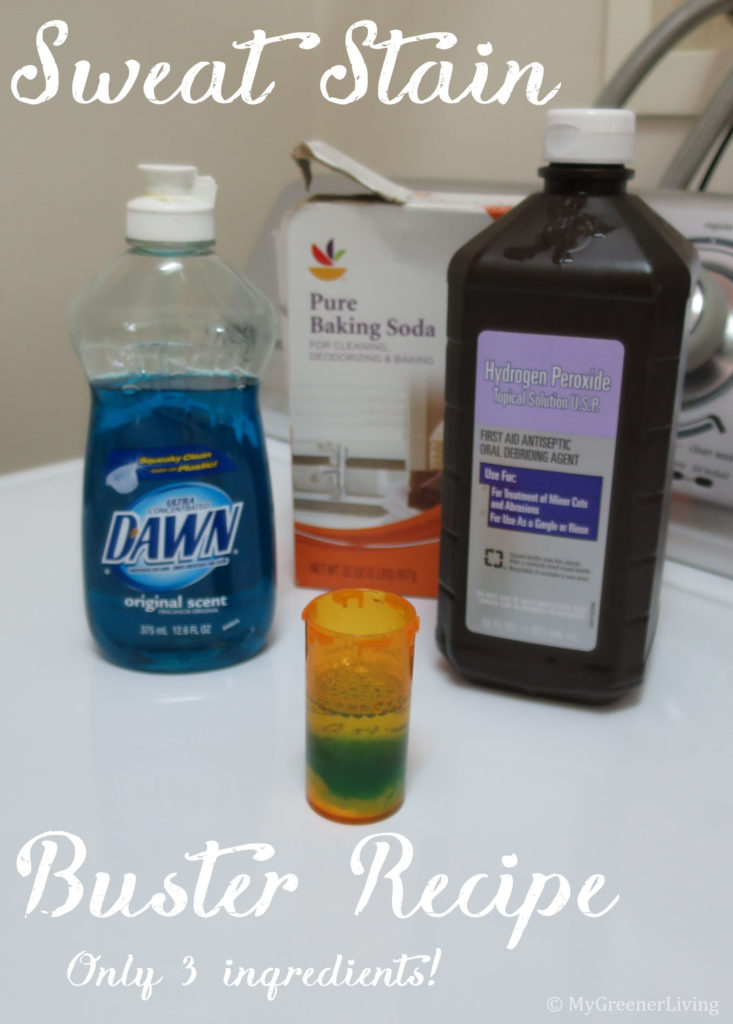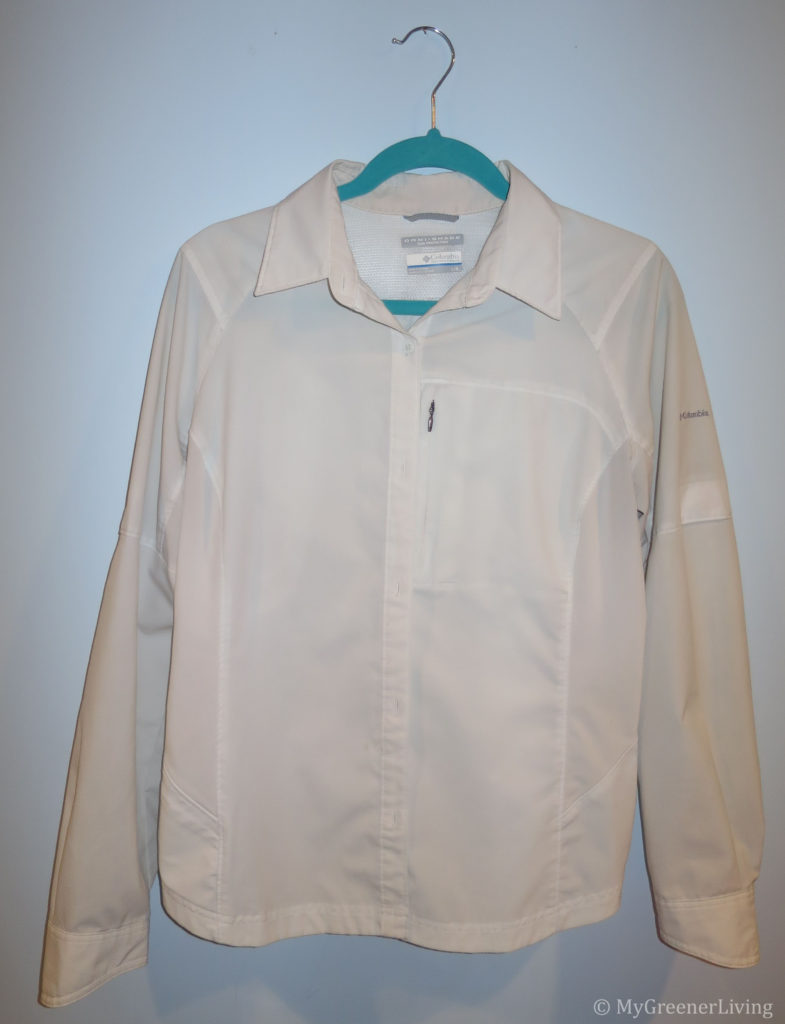One of the first recipes that I posted to this blog was a homemade, natural, liquid laundry soap. I have been using this laundry soap almost exclusively since I first made it about three years ago. I love my laundry soap because it is made with three simple ingredients (plus optional essential oils & water), it gets my clothes, towels, and sheets clean, and it does NOT stain and does NOT irritate my skin.

Disclaimer: This post contains affiliate links. See my Disclosure Policy for more information.
Searching for an easier-to-use laundry detergent
I recently traveled for a couple weeks at a time, and needed to do laundry away from home. I could have brought jars of my liquid detergent, but that is a hassle, especially when flying. I grabbed a pack of Laundry Dropps that my mom purchased for me 10 years ago, when I was in college. They are scent and dye free, and the current version of the product is rated OK by the Environmental Working Group, but I wanted a more natural formulation to regularly use on my laundry.
A natural homemade laundry soap “pod” (or powder!)
I looked back at my liquid laundry soap recipe and other than water, the ingredients were so simple…and I thought might make a nice solid laundry soap product: baking soda, washing soda, liquid castile soap, and essential oils.
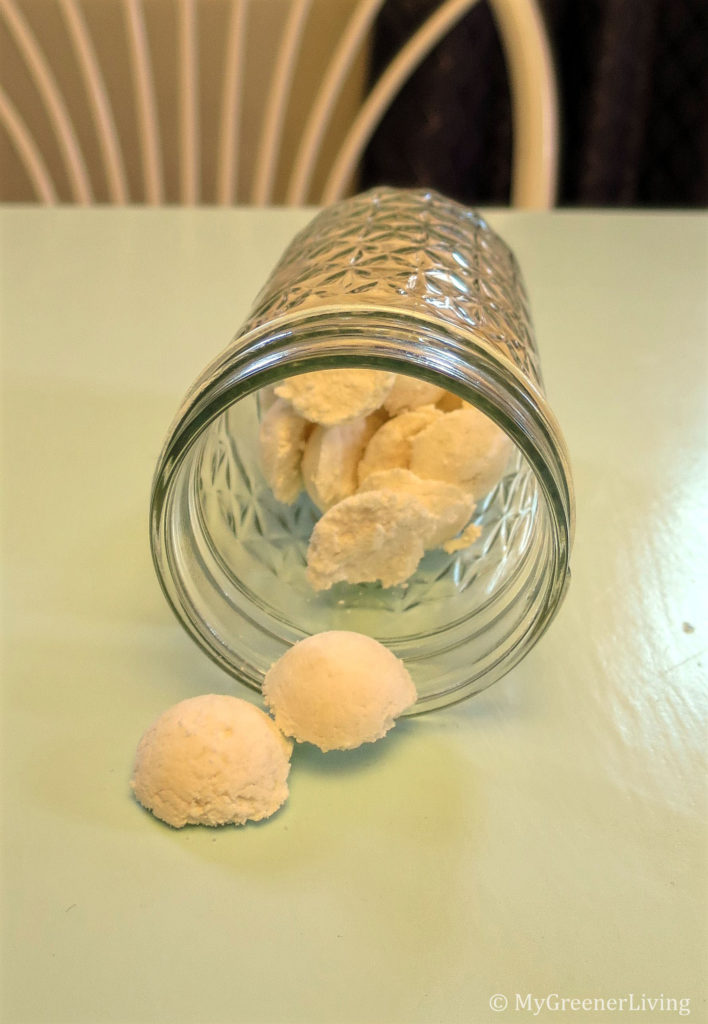
Note: Most solid form natural laundry soaps that I have found use solid soap bars to make the laundry soap solid. [As I have mentioned in my soap making blog posts, solid and liquid soaps use different types of lye to saponify the oils and form soap. Sodium hydroxide is used for solid/bar soap and potassium hydroxide for liquid soap.] I don’t like laundry detergents using solid/sodium hydroxide soap because, from my experience, this natural laundry soap requires hot water to dissolve the soap, and I usually wash my laundry with cold water.
Creating my natural laundry soap pod (or powder) formulation was far easier than I expected! I just used the ratio of baking soda, washing soda, and castile soap from my liquid laundry soap recipe, which happened to be a super-simple 1:1:1 (equal parts each ingredient), dumped all the ingredients into a bowl, added some lemon essential oil, and mixed it all together. It formed a clumpy mixture, almost the consistency of cottage cheese without the liquidy part. To use this as a powder form for daily laundry, I stop here, simply pouring the clumpy powder into a container with a seal to prevent spilling. To make into “pods” for taking when I go on vacation, I packed this clumpy powder into a round measuring spoon, and popped it out into a sheet of waxed paper. After drying overnight hours, the “pods” were no longer sticky and held together. Done!
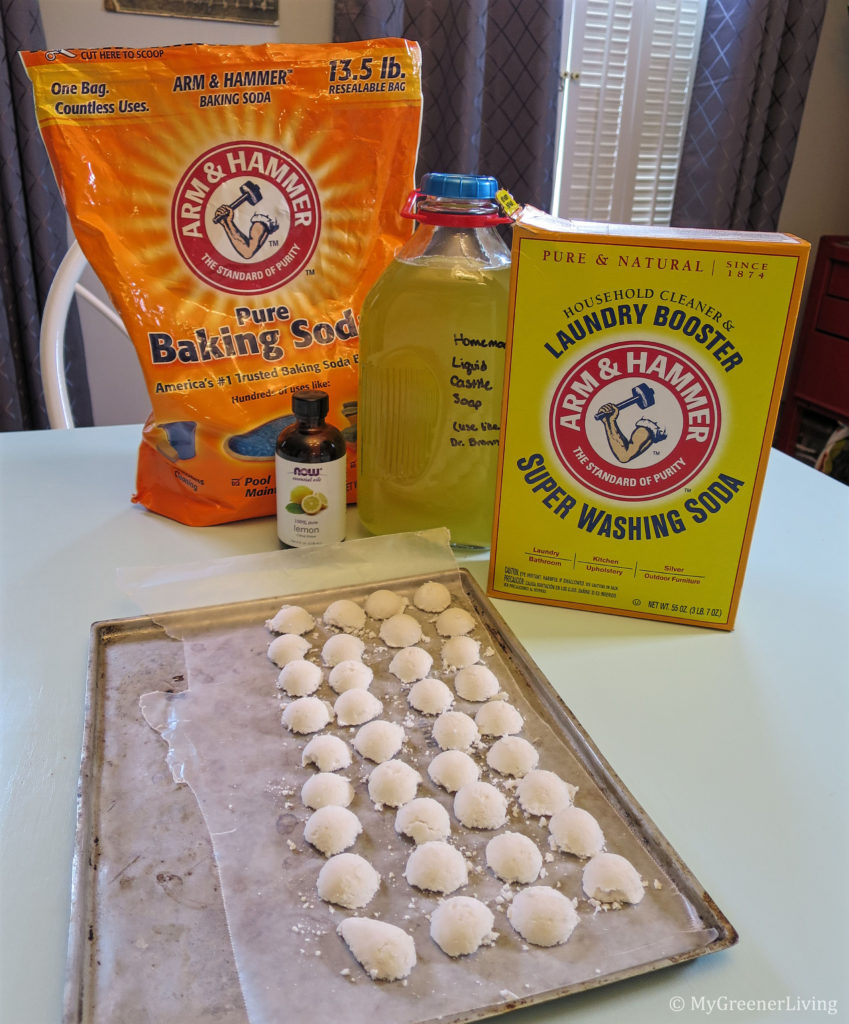
Each ingredient in the homemade natural laundry soap pod dissolves readily in water, so it works for washing in cold water. To use these “pods,” I drop in the washing machine, then load the laundry. This makes sure the “pod” is on the bottom and will contact water as soon as possible as the washing machine fills with water. This is very important for the high efficiency washers that use very little water! If the pod isn’t in the water, it won’t dissolve and cannot clean.
Homemade natural laundry soap “pod” recipe
This recipe is easy scale to any batch size because it uses equal amounts of each of the three base ingredients. The recipe below uses 1/4 cup (4 Tablespoons) as a base amount, and yields 48 “pods.” The volume amount that the recipe yields is the sum of the baking soda + washing soda – in the below recipe, 1/2 cup.
Scroll down for a simpler preparation and use as a powdered soap instead of a pod!
Ingredients
- 1/4 cup baking soda (sodium bicarbonate)
- 1/4 cup washing soda (sodium carbonate, also called soda ash)
- 1/4 cup (undiluted) liquid castile soap (Dr. Bronner’s or my liquid castile soap)
- 6-8 drops essential oil of choice (I like lemon)
Note: The essential oil amount in this recipe will not leave laundry scented – I like it for the cleaning power. For lightly scenting my laundry, I apply a few drops of an essential oil or oils to wool dryer balls before drying, as I discuss in this post.
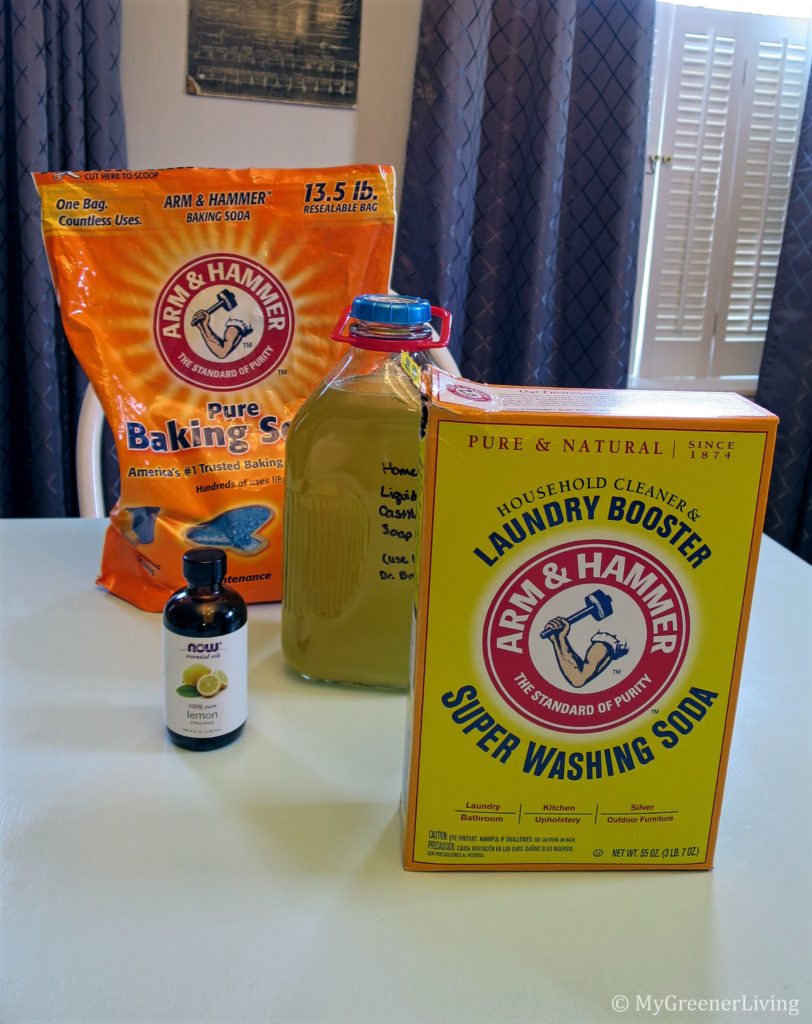
Supplies
- 1/2 teaspoon measuring spoon (round worked best for me)
- bowl with capacity larger than the amount of ingredients (I used 2-cup bowl)
- gloves, if desired to avoid contact with the mixture
- container that seals, for storage
Instructions
- Measure the castile soap and pour into a bowl. Add the essential oils and stir to evenly distribute the oil throughout the soap.
- Measure the baking soda and washing soda, and add to the bowl with castile soap.
- Mix the soap and sodas well. It will form a slightly moist, clumpy powder. If leaving as a powder, pour into an airtight container to store. If making pods, continue.
- Pack the mixture into the 1/2 teaspoon measuring spoon (I used my thumb), and slide the “pod” out of the measuring spoon onto a plate or tray for drying.
- Allow to dry for at least one day, then store in an airtight container and store out of reach of kids and pets.
Note: If the mixture is too dry and will not stay together when packing into the measuring spoon, use a spray bottle to add a tiny bit of water at a time. Stir after each spritz of water until a workable consistency is achieved. I had to spray a few times as I was working to form these pods. Alternately, if the mixture is too wet and sticks to the measuring spoon to much to remove, sprinkle baking soda a pinch at a time and mix in, until a workable consistency is achieved.
Alternate (super quick and simple) method: Does making these “pods” sound like too much work? I hear you! We’re all busy. The super quick and simple method is to do steps 1-3 above. When it’s laundry time, I scoop a slightly heaping 1/2 teaspoon of the mixture into the washing machine for a normal size load, and a slightly heaping 1 teaspoon for an extra-large load.
This alternate method is also GREAT if you live in a humid climate. I found that my pods started to crumble when the weather was more humid. I like to keep a handful of “pods” ready for taking on vacations, but for my day-to-day laundry I like to keep the laundry soap as a powder and just use my measuring spoon to scoop into the washer when I am doing laundry at home.
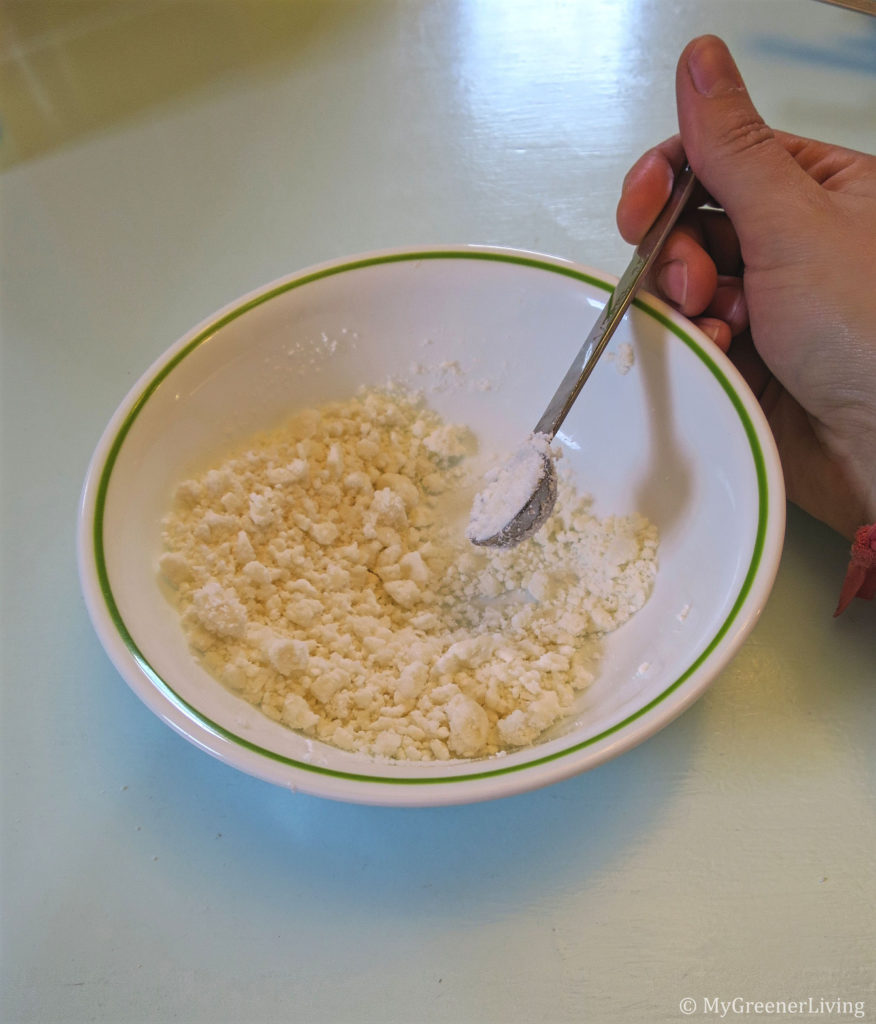
How I use the homemade natural laundry soap pods or powder
I use 1 “pod” or 1/2 teaspoon powder (yes, just 1/2-teaspoon) for each regular load of laundry. I use 2 “pods” or 1 teaspoon for extra large loads, like sheets and towels.
I drop the “pod(s)” into the washing machine, then load laundry in the washing machine. If I am using the powder (skipped the pod-making step) I use a 1/2 teaspoon measuring spoon to scoop a slightly heaping 1/2 teaspoon into the washing machine before loading the laundry. For extra-large loads I use 1 teaspoon.
Each ingredient in the homemade natural laundry soap pod/powder dissolves readily in water*, so it works for washing in cold water. Since I want to ensure that the “pod” or powder contacts the water and therefore dissolves so it can clean my laundry, I always put the “pod”/powder in the washing machine first. This is especially important for the high efficiency washers that use very little water. If the pod/powder isn’t in the water, it won’t dissolve and cannot clean.
*Since the essential oil is blended with the castile soap and the castile soap is soluble in water, the oil will get distributed in the washing water as well. For a detailed scientific explanation of this, check out the end of my DIY Toilet Spray post.
I use these natural laundry soap pods or powder for cleaning my clothes, sheets, and towels that are dirtied in my normal use. What this means is that the “dirt” is organic – body oils, plant-based oils (I moisturize with natural products), dead skin cells, good old-fashioned dirt. These types of “dirty” can all be cleaned with a natural soap. If I need to clean something that has been dirtied by a synthetic oil or grease (such as bicycle chain or machine oil), I need to use a detergent. Natural soaps just don’t cut it (pun intended). My post here goes into this in more details.
I would love to find a natural soap that works to clean synthetic oils and greases, but I don’t know of anything. If you have found or made a product that does this, please share with us in the comments!
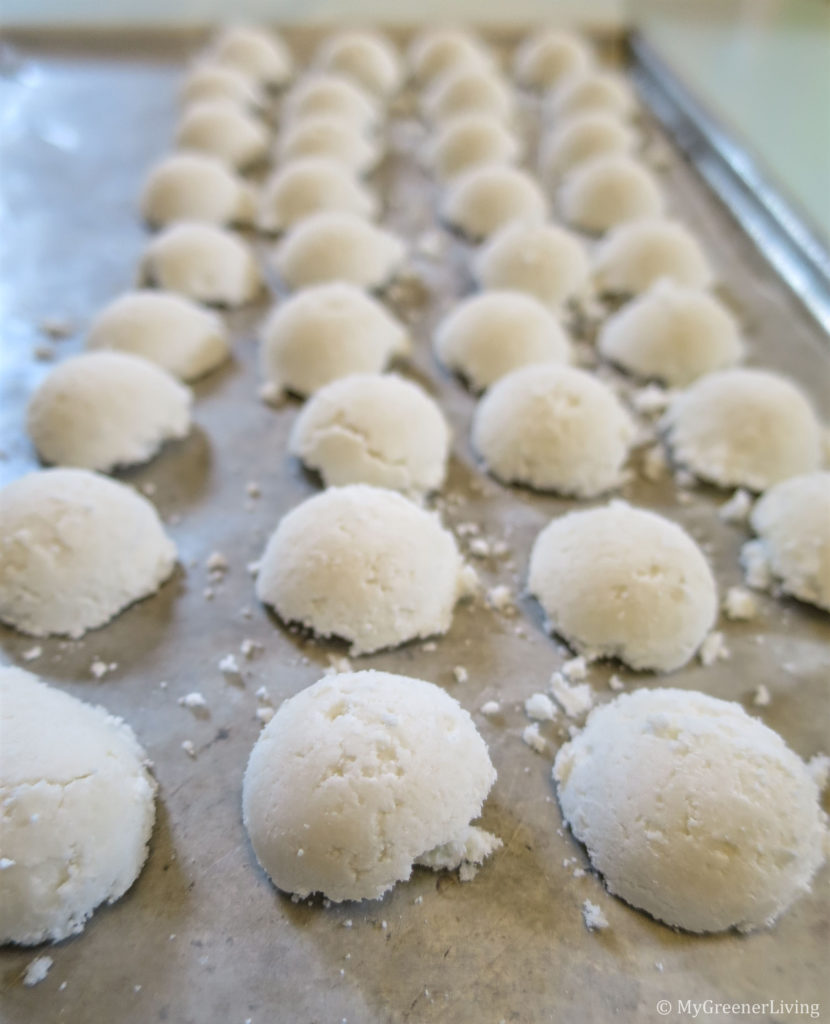
Am I sure these tiny pods are enough to clean my laundry?
I, too, was skeptical about how small the pods are and how little powder I use. 1/2 teaspoon? Most laundry pods look to be about 1 Tablespoon. This is 1/6 that amount! And most liquid laundry detergents use 2-4 Tablespoons per load. Well, there are a couple reasons that I think this small amount of laundry soap works. First, is that this is the same amount of each ingredient that is in my liquid laundry soap (see below), and that laundry soap has been cleaning my clothing quite well for 3 years and counting. Second, the reason commercial laundry detergents have such large amounts per use is that they are a business, and businesses seek to make money. More detergent used per load = detergent used up faster = consumer purchases more detergent = business makes more money.
[Math to prove my above point: recipe with ½ cup baking soda, ½ cup washing soda, ½ cup liquid castile soap was used to make a total of 96 fluid ounces of laundry soap. This is equal to 192 Tablespoons. I use 1-2 Tablespoons of this liquid laundry soap per load of laundry. Let’s say I use 2 Tablespoons per load. This means I get 192/2=96 loads of laundry per batch. This laundry pod recipe uses half as much of each ingredient, so if I made it liquid, it would yield 48 fluid ounces which is equal to 96 Tablespoons. 96 Tbsp/(2Tbsp per load) = 48 loads. This laundry “pod” recipe makes 48 “pods.”]
CAUTION
As with any household cleaner, keep out of reach of children and pets. While the laundry “pod”/powder is made from all natural ingredients, it can still cause harm if ingested, if contacting eyes, possibly if contacting skin, and there may be other ill effects.
I mixed this up my hand and used my bare thumbs to pack the mixture into the measuring spoon, and had no irritation or ill effect. However, everyone reacts to ingredients differently, so please use caution if you make and use these laundry “pods” or powder.
Cost
Baking soda. $0.99 for 1 lb on Amazon and in grocery stores. ($0.99/1 lb)x(1 lb/454 g)x(4.8g/1 tsp)x(24 teaspoons per batch)=$0.251
Super Washing Soda, (also called sodium carbonate and soda ash), is about $5 for 55oz at Walmart and my local grocery stores. Super washing soda weighs about 70 grams per 1/4 cup (I weighed it). 55 oz = 1559 g. $5 x (70g/1559g) = $0.224
liquid castile soap. For ease of calculation, I’ll use the price from Amazon vs. my homemade soap– $15.99 for 32 oz. ($15.99/32oz)x(2 oz)=$1.00
lemon essential oil. Available on Amazon for $12.99 for 4 oz. ($12.99/4oz)x(1 oz/600 drops)x(7 drops)=$0.038
Total cost is $1.513 which rounds to $1.51 per batch. One batch is good for 48 regular size loads of laundry, so $1.513/48=$0.032, or just over $0.03 per load of regular laundry, and just over $0.06 for an extra large load. What a great price!
For comparison, Dropps are $0.17 to $0.31 per load depending on how much is purchased at a time. Even at the least expensive price, my laundry “pods” are less than 1/5 the cost of Dropps!
Do you prefer liquid, powdered, or pod form for your laundry soap? Let us know in the comments below!

